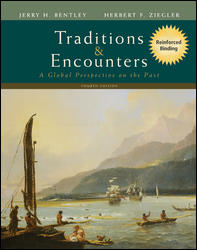Traditions and Encounters, 4th Edition (Bentley)Chapter 37:
NEW CONFLAGRATIONS: WORLD WAR IIOverviewThe Second World War (1939–1945) was indeed a conflagration such as the world had never seen before. There was no precedent for scale of the devastation, the millions of dead, the unimaginable barbarity. World War II was the defining event of the twentieth century. It determined the global powers, the global alignments, and many of the issues for the next generation. Some aspects of the war to consider as you read: - Appeasement. The causes of the war are complex but must include the failure of western democracies to take seriously the threat of fascism. When Japan invaded Manchuria in 1931, when Italy seized Ethiopia in 1935, when Germany claimed first the Sudetenland and then all of Czechoslovakia in 1938: at every turn, world leaders decided to appease the aggressor rather than risk a war.
- Isolationism. Sunk in the depression, Britain, France, and the United States erected walls of tariffs against imports, which only deepened the global depression. Disillusioned with the outcome of World War I, the western democracies did not maintain their military strength. When the next war came, they were ill prepared.
- Total war. Like the First World War, the second involved whole populations on an unprecedented scale. Women on both sides performed industrial work and joined auxiliary forces. Civilians were targets of war through aerial attacks, blockades, rape, and internment. Civilian casualties were in the tens of millions.
- Genocide. Certainly the most horrifying aspect of the war was the Nazi attempt to methodically exterminate the entire Jewish population of Europe, along with other "undesirable" populations. Nearly six million Jews were killed in the death camps.
- An uneasy alliance. Capitalist and communist states found common cause in the battle against fascism. By keeping up the pressure on two fronts, the Allies eventually crushed the Axis Empire. However, by the end of the war, the alliance between Britain, the United States, and the Soviet Union was frayed and unstable.
- Postwar uncertainties. At the Yalta conference of 1945, the Allies agreed that the Soviets could establish temporary governments in eastern Europe and eastern Germany in exchange for Stalin's pledge to help the United States defeat Japan. These puppet states were supposed to be temporary but instead became permanent dependents of the Soviet Union. The postwar conflict between the United States and the Soviet Union was already apparent.
 | 
















